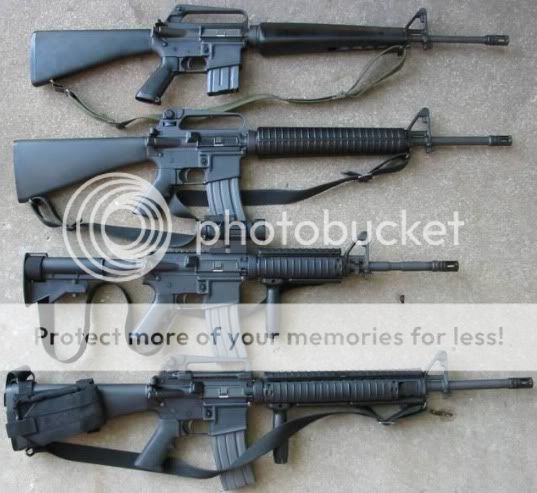
Weapon Name- M16
Type- Assault rifle
Damage- 2L
Range- 125/250/500
Ammunition- 1100 rounds per 27.5 pounds
Strength Level- 2
Strength Level for firing- 2 for short burst, 2 for medium burst, 2 for extended burst or fully automatic
Special Consideration- -2 to Reliability rolls. If more than 90 rounds are fired in a minute, the weapon will jam. Re-roll 8's.
Because each of the rounds are so lightweight, they are easily deflected. Every shot suffers a -1 modifier when attempting to strike a concealed opponent, and -1 modifier to all armor rolls except body armor. In addition, the rounds suffer inherent penalties, being stopped by: One thickness of well-packed sandbags, A 2 inch (51 mm) non-reinforced concrete wall, A 55 gallon drum filled with water or sand, A small ammunition can filled with sand, A cinder block filled with sand (block will probably shatter, A plate glass windowpane at a 45° angle (glass fragments may be thrown behind the glass), A brick veneer, A car body (round will penetrate but normally not exit). In reinforced concrete of all types, the 5.56mm are incapable of cutting or going through the steel bars.
Round Type- 5.56mm x 45mm NATO
Over-all length- 1000mm (39.5 in)
Barrel length- 508mm (20 in)
Weight- 7.8 lb (3.5 kg) (unloaded)
8.79 lb (4.0 kg) (loaded)
Rate of Fire- 700-900 rounds/min (cyclic)
Feed Mechanism- Detachable Box Magazine, STANAG compatible
Round Capacity- 20, 30-round STANAG magazine or 100-round Beta C-Mag
Accuracy- 2-2.5 MOA
Accessories- Picanty Rail
Quick switch firing mechanism- N/A
Scope/Sights- Picanty Rail
Muzzle Velocity- 940 m/s
Firing System- Gas-operated, rotating bolt, direct impingement
Miscellaneous/electronic information- Essentially one of the first and least reliable 5.56mm x 45mm NATO assualt rifles.
Basic Information
The M16 is a lightweight, 5.56 mm, air-cooled, gas-operated, magazine-fed assault rifle, with a rotating bolt, actuated by direct impingement gas operation. The rifle is made of steel, 7075 aluminum alloy, composite plastics and polymer materials.
The U.S. Air Force's rifle, the M16, and the United States Marine Corps and Army rifle, the XM16E1, were the first versions of the M16 rifle fielded. Soon, the U.S. Army standardized the XM16E1 as the M16A1 rifle, an M16 with a forward assist feature requested by the Army. All of the early versions were chambered to fire the M193/M196 cartridge in the semi-automatic and the automatic firing modes. This occurred in the early 1960s, with the Army issuing it in late 1964.[10] Commercial AR-15s were first issued to Special Forces troops in spring of 1964.[11]
A U.S. soldier on NBC exercise, holding an M16A1 rifle and wearing an M40 Field Protective Mask. Note the receiver, forward assist and the barrel flash suppressor.
The M16A2 rifle entered service in the 1980s, chambered to fire the standard NATO cartridge, the Belgian-designed M855/M856 cartridge.[10] The M16A2 is a select-fire rifle (semi-automatic fire, three-round-burst fire) incorporating design elements requested by the Marine Corps:[10] an adjustable, windage rear-sight; a stock 5/8-inch longer; heavier barrel; case deflector for left-hand shooters; and cylindrical handguards.[10] The fire mode selector is on the receiver's left side. The M16A2 is still the primary rifle in the U.S. Navy, Coast Guard, Air Force, and still is in heavy use in the Army and Marine Corps.[citation needed]
The M16A3 rifle is an M16A2 rifle with an M16A1's fire control group (semi-automatic fire, automatic fire) used only by the U.S. Navy.
The M16A4 rifle was standard issue for the United States Marine Corps in Operation Iraqi Freedom; it replaced the M16A2 in front line units. In the U.S. Army the M16A2 rifle is being supplemented with two rifle models, the M16A4 and the M4 carbine as the standard issue assault rifle. The M16A4 has a flat-top receiver developed for the M4 carbine, a handguard with four Picatinny rails for mounting a sight, laser, night vision device, forward handgrip, removable handle, or a flashlight.
The M16 rifle is principally manufactured by Colt and Fabrique Nationale de Herstal (under a U.S. military contract since 1988 by FNH-USA; currently in production since 1991, primarily M16A2, A3, and A4), with variants made elsewhere in the world. Versions for the U.S. military have also been made by H & R Firearms[12] General Motors Hydramatic Division[13] and most recently by Sabre Defence.[14] Semi-automatic versions of the AR-15 are popular recreational shooting rifles, with versions manufactured by other small and large manufacturers in the U.S.[15]


